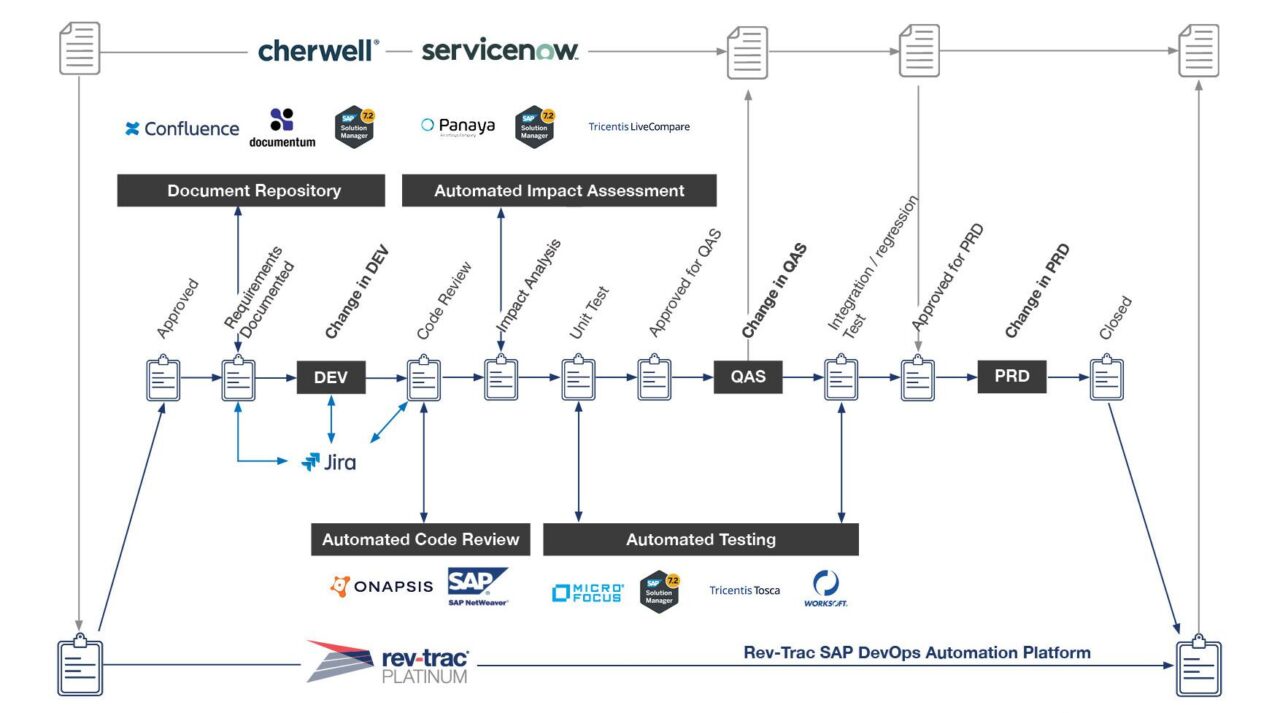If you are considering an SAP DevOps approach, you are probably thinking about integrating automated SAP tools to fast track the journey.
It hasn’t always been the case. Just over 10 years ago, we integrated Rev-Trac with another SAP third-party tool to help organizations better manage change across SAP landscapes.
The innovation, the time has shown, was ahead of market demand. It wasn’t on the radar of most organizations. Simplifying SAP change management was the focus for much of the decade.
Today, however with the spotlight on SAP DevOps, integration has become a buzzword. It dominates the conversation on anything related to SAP change management.
A unified SAP DevOps toolchain for end-to-end delivery
A challenge for large IT teams building tightly integrated SAP DevOps backends is too many siloed stakeholders with separate focus areas.
Test managers concentrate on testing, while Dev team leads want to deliver more code faster. Meanwhile, Ops teams are nervous about what is coming into their production environment.
Yet, what is common is the desire for their area of focus to be automated while reducing the risk of unscheduled downtime.
The result. The competing objectives cloud the decision of what tools to invest in that primarily work on the same value stream.
Often, companies that are most successful at improving the value stream are smaller organizations that can assign individuals to control the end-to-end delivery of change.
Decentralizing authorization and centralizing the information is critical to designing an excellent value stream delivery mechanism that supports SAP DevOps initiatives.
This approach allows users to work on their tasks in their respective environments. At the same time, people who need to see information relating to SAP change can easily access data from a central location.
In our experience, our conversations with customers and prospects alike focus on DevOps toolchains and allowing the right tool to be called at the right time, every time.
Fast track your SAP DevOps journey
You may have seen this unified SAP DevOps toolchain in other blogs that tackle SAP change management ITSM tools integration and DevOps.
Rev-Trac Platinum, the SAP DevOps Orchestration Platform, integrates with third-party ALM and DevOps toolsets and incorporates them into highly flexible end-to-end workflows to meet DevOps initiatives. This orchestration automation has been available to Rev-Trac customers for over a decade.
Rev-Trac’s powerful DevOps orchestration capabilities see it as the ultimate centerpiece for storing change and triggering automations related to an SAP change management process. It is the centralized point of control for the unified DevOps toolchain, automating and orchestrating a low-risk approach to SAP DevOps success.
How does this all work, and what gains might you think of?
As I mentioned earlier, it is critical to decentralize authority and centralize information. Where to locate the information is the first decision organizations that adopt this process need to make.
For Rev-Trac customers, the question usually is Rev-Trac or an ITSM tool.
The amount of SAP development vs non-SAP development typically determines the response. An organization with predominantly SAP change will find Rev-Trac a more natural location for centralization.
However, an organization that has a majority of non-SAP development will generally gravitate towards ITSM toolsets as the place to centralize change.
Rev-Trac, of course, handles both scenarios very well. The software acts purely as an orchestration engine (where the ITSM tool is the source of information) or as an auditable change management and orchestration tool (where Rev-Trac is the source of information).
Here are two examples that highlight Rev-Trac’s use as a source of information:
Case 1
If configured, a request in the ITSM tool automatically creates the Rev-Trac request (acting as an authorization for work to commence). Developers collate the specification documentation and the transports required to deliver the change on the Rev-Trac request (centralizing the information).
All authorizations for the build of the change happen at the Rev-Trac level. Once the change is built and ready for deployment, Rev-Trac can wait for approval in the ITSM toolset before deploying transports to production (decentralizing the authorization).
Case 2
With development underway, there will be a point in your process where you will need to perform QA testing. In this setup and under this scenario, Rev-Trac automatically calls your test automation tool.
Rev-Trac alerts your test tool that there is a role to play in this change and provides all the necessary information to run the correct test scripts.
After testing, these results are automatically attached to the Rev-Trac request, and sign-off takes place based on the test results.
In this instance, the authorization is controlled by a test result within the test tool (decentralizing the authority), while Rev-Trac captures the result (centralizing the information).
You can apply these approaches for centralizing information and decentralizing authorization to any section of the SAP DevOps toolchain that contributes to an organization’s SAP change delivery.
If you have any questions or want more information about SAP DevOps and how Rev-Trac Platinum can help your organization reach its objectives, please contact one of our SAP change management experts.



